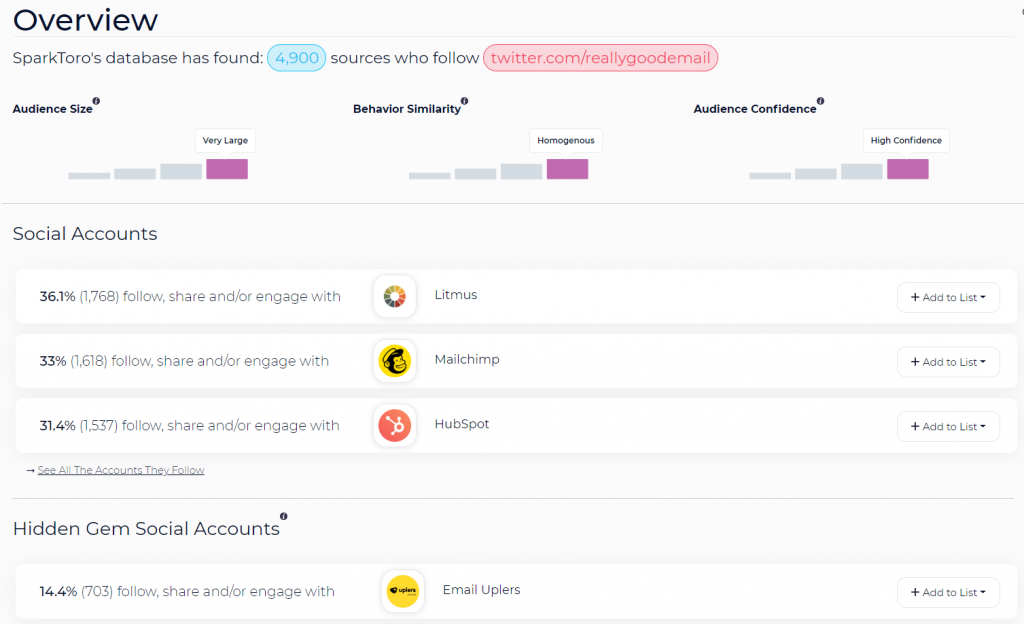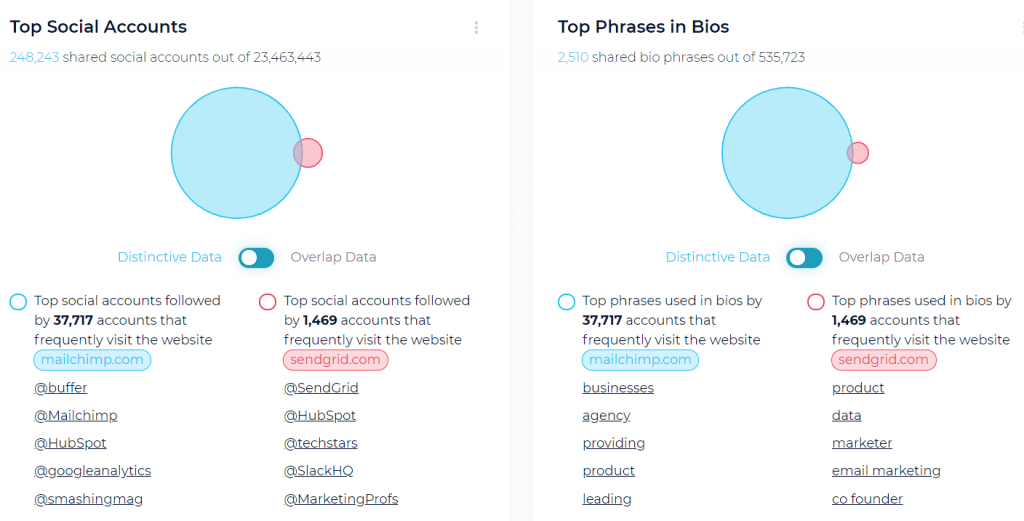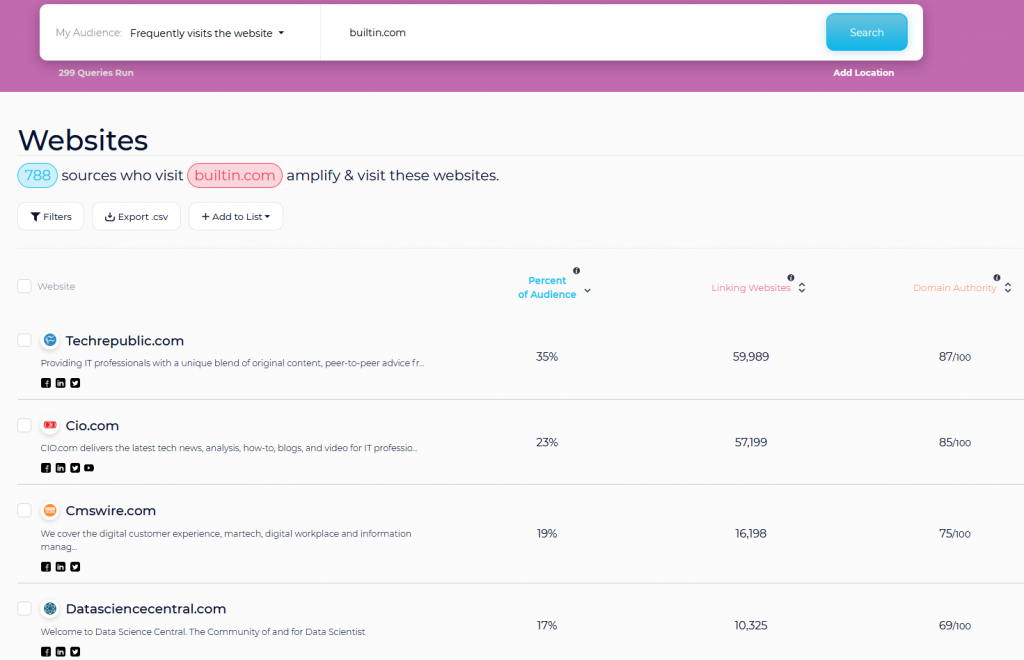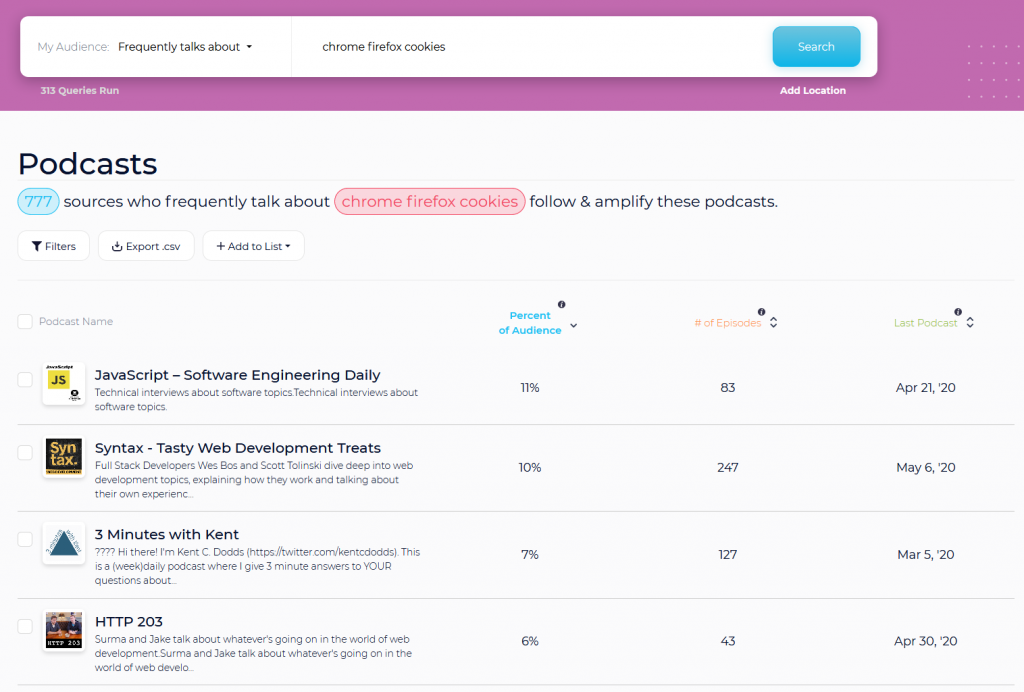Before SparkToro existed, the process of researching a brand’s audience was a frustrating one. I know, because I helped a lot of friends, especially those pursuing early stage ideas or launching new products. It took forever — usually months, sometimes 6+. The data was always self-reported (which meant it was often wrong). And scale was simply unobtainable. We could survey and interview 50, even 250 targets. But 1,000? 5,000? Forget it.
When this hypothesis-turned-real-life-product came out, I worried whether marketers would “get it.” SparkToro isn’t comparable to other tools. It’s not even in an easily describable space. A lot of marketers consistently do the work the tool helps with, but that doesn’t mean it was a slam-dunk to pitch… not by a long shot. Thankfully, it feels like some folks really are getting it.

Via Katelyn Bourgoin on Twitter
But, let’s be real. Not everyone’s as on-the-ball as Katelyn.
We’ve seen confusion on how exactly to use the product, what it can help accomplish, and what makes for a good search vs. a bad one. Today, I’ll try to help with that. Smart use of SparkToro stems from a need to better understand your audience, with real-life, practical tactics attached to those, so I’ll show not only ideas of searches to try, but also how to use the data you get back. Since your first five searches each month are free, let’s start with ten (to cover month 1 and 2).
Search 1: Your Brand’s Social Account
How well do you know the people that follow your brand/account on social networks? And how well do you know what else they follow, read, watch, visit, and listen-to? When I ran these searches for my own account, the first few results were no surprise (though the % following column often was), but as I scrolled down, I found more and more interesting, unique, and most importantly — sources worth forming connections with.

Example Search for Follows the Social Account: twitter.com/reallygoodemail
I often start with Twitter (the network I use most) but Facebook, LinkedIn, Pinterest, and more work, too. The best part is SparkToro will connect up networks so you don’t need to separately input various profile URLs — our database usually knows all the social profiles for an entity.
How to use this data:
1) Find sources that reach your audience that you’re not familiar with and start following, listening, and reading them to learn more about the media your customers likely consume. The more you know about what your customers consume, the better able you’ll be to reach them with messages and content that resonates.
2) If you uncover indirectly competitive sources you haven’t built a relationship with, reach out! Guest content, co-marketing, partnerships, joint webinars, being a guest on their podcast/YouTube (or having them on yours) are all ways to grow your audience reach with a group you KNOW has a strong affinity for what you do.
Search 2: Comparison vs. a Competitor
SparkToro’s Comparison Search can show two kinds of data: what’s unique about different audiences, and what they have in common. Try plugging in a competitor’s website or social account and your own — you’ll uncover properties of the audience you and your competitor share (“overlap data” in the tool) and those unique to each of you (“distinctive data”).


How to use this data:
1) Use the sources heavily followed by your competitors’ audience as places to consider doing marketing of your own — especially the individuals on social and with publications. Making a fan out of someone who’s well-followed by your competitors’ audiences can help persuade those folks to give your company a shot.
2) Contrast the bio/profile and hashtag data between the accounts and see if there’s a glaring hole in an audience you’re missing that your competitor’s reaching. It could be your marketing hasn’t penetrated that audience yet, and if those folks are “right fit” customers, you can figure out why, then close the gap.
Search 3: A New Audience for Your Product(s) or Content
Got a hypothesis about a new type of customer you should be going after? Or maybe you’ve got some new content marketing efforts you think would resonate with a previously untapped group of people?
If you know words and phrases that group is likely to have in their profiles (what Twitter calls “Bio,” LinkedIn calls “Headline” and “Title”, Facebook calls “About”, etc), you can search SparkToro to learn invaluable data about how they behave online.

Example Search for Uses these Word(s) in Their Profile: HR Director
How to use this data:
1) Advertising and media buying. This may seem obvious, but if you uncover sources — websites, podcasts, YouTube channels, social accounts — that reach this new group you want to target, ads might be the quickest way to test whether your product/service and messaging works.
2) Try a few content pitches. Pick out publications and social accounts that reach your target audience. Shoot them a Twitter/Instagram DM, LinkedIn message, or email and see if they’d accept a guest editorial or contribution.
3) Ask for amplification directly. If you’ve got a piece of content, a story, even a product that you think is a perfect match for someone’s followers, just ask. I get pitches like this all the time, and honestly, the good ones work, often getting me to share on my LinkedIn/Twitter/FB or include as a reference in a blog post.
Search 4: A Website that’s Sent You Valuable Traffic Before
Open up your Google Analytics. Click to Acquisition > All Traffic > Referrals.

Look down the list for niche websites that have sent valuable visits. If you’ve got goal tracking set up, that’s a great metric to use, and if not, look for higher pages/session, session duration, or sort by visits that made it to a particularly valuable page (maybe your checkout, email signup, or a free trial URL). Take one or more of those websites that sent you great traffic and plug it into SparkToro’s “frequently visits the website” search.

Chances are strong that websites with a substantive audience overlap could also send you great traffic!
How to use:
1) Run some ads. Especially if these are media publications, and with ad prices as low as they are right now, you might grab not just decent-ROI traffic, but some worthwhile brand building, too.
2) Do some creative co-marketing. Joint webinars (where you get the list of the attendees’ contact info), guest appearances on their podcast/video content, a sponsored PR piece — all can work.
Search 5: A Job Title Common Among Your Best Customers
If you’ve got any type of self-reported data from your existing customers about their job titles and roles, you can plug those directly into SparkToro and get superb insight into where to reach more people like them. If you don’t… a service like FullContact’s Person API could help. You’ve likely got emails, and with FullContact, you can turn those emails into fully fleshed-out datasets including demographics like job title (or you can go the low-cost route and manually search LinkedIn).
Sort by the most common job titles among your customers, and run that search in SparkToro’s “frequently uses these word(s) in their profile:”

How to use:
1) Video pre-roll and re-targeting ads might be particular effective, especially if your niche is small and there are hyper-targeted channels to reach.
2) Anytime you’ve got information that’s of particular interest to folks with a specific job, content marketing pitches work really well. If you don’t already have that content ready, a survey of your audience, or an aggregation of stats about relevant trends can earn a lot of press from the publications in their field.
In month two (with your second set of 5 free searches), we can dig even more deeply into the details of your potential audiences…
Search 6: Big Topics of Discussion in Your Industry
Did a blog post or news story get heavy traction on Twitter last quarter? Maybe a whitepaper or bit of research hit the LinkedIn crowd? Or perhaps the buzz in your field suddenly turned to a controversial or engagement-heavy subject? Using the “frequently talks about” search option, you can learn more about the audience that discussed it.

For example, at the intersection of web development, analytics, and marketing tools, there’s been a big discussion around third-party cookies and how Firefox and Chrome are killing media & advertisers’ ability to use them. A search for Chrome Firefox Cookies shows 777 sources that have discussed this in the last ~100 days, along with how to reach that audience.
How to Use:
1) If you have an angle, pitch, content piece, or product related to these discussions, this might be the perfect outreach list.
2) Or, if you’d rather have that content on your own site, consider reaching out and asking some of these influential sources if they’d be up for an interview, a video, or writing a guest piece for your publication.
Search 7: A Hashtag Popular with Your Audience
The hashtag search option can show a goldmine of audience data. You’ve just got to choose the right ones. I’ve found that describing a niche audience and then looking through the hashtags they use via the “Audience Insights” tab in SparkToro can provide a wealth of data.
For example, I ran a search on “Uses these word(s) in their profile: Accountant” and got a healthy list of popular hashtags from the prior three months:

Now I can take a hashtag like #taxseason and find golden opportunities to reach a very precise audience.

How to Use:
1) Because hashtag users tend to be more active social media commenters, potentially controversial data, research, or content can do very well among these groups (and thus, with the sources they follow).
2) These sources (and even the hashtags themselves) are also perfect for finding content and media opportunity inspiration.
Search 8: A Comparison of Two Media Sources Your Audience Reads
The comparison search is useful for analyzing overlaps between two audiences, but it’s also great for getting a quick view of the differences between groups. For example, if my audience is graphic designers, and I’m trying to see whether a pitch, ad, or co-marketing effort is better placed on DesignTaxi vs. Behance, the side-by-side bio analysis might really help.

How to use:
1) Pick a few media sources you’re planning to target (with marketing or advertising of any kind) and run them through a comparison to see what attributes the publications have in common, and what separates them. This can help you decide which to prioritize and how to experiment.
2) It might even tell you there’s other publications to consider first! If you look down the list of profile/bio words or hashtags and find ones that resonate, plug those into SparkToro and make sure the publication you’re targeting really *does* reach that audience better than the alternatives.
Search 9: A Discovery from a Previous Search’s Audience Insights
When I ran the search above comparing DesignTaxi and Behance, I found a few websites in the graphic design space I hadn’t previously heard about, including ItsNiceThat.com. A click later, and I’ve got some killer data about whether they might be right for future targeting efforts.

How to Use:
1) Confirm whether a website or social source could make for a compelling target. Do they hit the right kinds of profiles? Do they match the geography you’re going after? Are they in a bucket with sites/sources that match your reach goals?
2) Are there other searches (hashtags, websites, social accounts, profile/bio words, etc) that might uncover more-targeted or higher-relevance sources? The data in a profile search can easily expose those opportunities.
Search 10: That “Influencer” or Media Outlet Your CEO Insists You Need to Get
Sure, the Wall Street Journal has a big audience. And yes, it’s entirely possible that some of your target audience reads it. But, WSJ is mostly subscription access, the ads are ludicrously expensive (because it’s “prestige” advertising rather than a high-intent publication), and the chances the WSJ outperforms a more niche publication for *your* business is vanishingly small.
Still, in meeting after meeting, executives think their audiences probably behave like they do, and thus media buyers and marketers should target the publications they *feel* are right. Poppycock! Well, now you can prove ’em wrong.

In your case, it might not be the Wall Street Journal, per se, but there’s almost always a “prestige” placement that execs prioritize despite a lackluster overlap with an audience that converts. Run that search, show ’em the stats, then run searches for your core audiences and find where their prestige publication actually ranks with your customer targets.
How to use:
1) Break the news gently 😉
2) Get to work marketing in places that actually reach your customers
If Those Ten Aren’t a Match…
Try using your free SparkToro searches the way some of our early customers (below) have been. They’ve got ten alternative suggestions to those I’ve shown above:

Via Jay DiPietro at The Ricciardi Group

Via Britt Klonz

Via Cyrus Shepard

Via Liz Parker at Magnificent Marketing

Via Tara Hunt at Truly, Inc.

Via Justin Adelson at Perfect Pixel Marketing

Via Madeline Turner at LoopVOC

Via Alec Ploof at Moment

Via Juhli Selby

Via Michael Lorenzos at Manual Men’s Health
If you’re stumped on uncovering an audience inside SparkToro, I’m also happy to help directly. You can tweet at me, or drop me a line: rand at sparktoro dot com. Happy Searching!